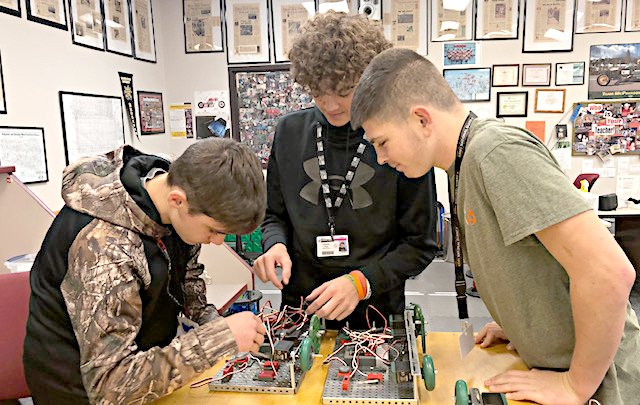The name of the game this year is “Tipping Point.”
For Great Bend High School’s robotics students, VEX’s game for the 2021-22 season comes with a touch of irony.
Over the past three years, Jake Hofflinger’s students in his Production Engineering and Robotics class have worked with components provided by VEX Robotics in the hopes that they could attend, and maybe win, a tournament competition.
This season, however, “COVID has the backorder on new robots pushed back to April, so we are not able to attend any Robotics meets this year,” Hofflinger said. Last year, the Panthers missed out on competitions due to travel restrictions imposed by the pandemic.
Undaunted, the students have pressed on, in hopes they will get a competition-ready robot up and running.
“Each year, we have purchased the game field and set it up in my classroom,” Hofflinger noted. “We can build the bots, even if we do not get to go to the meets.”
Know your VEX
While most competitive seasons run for portions of a year, the competitive robot season, as defined by VEX participants, runs from one May to the next, all year long. VEX, which has provided robotic platforms for all student levels since 2007, has expanded to more than 20,000 teams in more than 50 countries in 2021.
The competitions are divided into three basic levels: VEX V5, for middle and high school students; VEX IQ, for elementary and middle school students; and VEX AI, for advanced high school and university students. In each of the three leagues, students are given a new challenge at the end of the World Championships in May. Students then begin to design, build, program and drive a robot to the best of their ability.
Last year’s challenge was “Change Up,” where robots met on a 12- by 12-foot playing field. Four teams, two to a side, scored points by stacking balls into goals to form a row. The game was “changed up” as bots could knock the other side’s balls out of a stack.
In this year’s challenge, alliances meet on the playing field strewn with ramps and mobile scoreposts with branches. To score points, bots attempt to put rings on the scoreposts, getting one point for landing in the base three points for a low-peg ringer and 10 points for the high peg. For the first part of the game, the bots must rely on their own programming; for the last portion, team drivers can score more points by using a controller.
In each case, VEX supplies the components to teams for assembly, as well as game field elements for practice. The bots run on their own proprietary “C code” that students must learn, program, test and run.
In class, the game goes on
This fall, Hofflinger’s classes were introduced to VEX by first constructing a “test bed” for components they will be using. The test bed introduces students to the hardware, software and the components. Later on they’ll set up controllers using the “Robot C” software, Hofflinger said.
Students first perform experiments with a variety of sensors and motor types, then answer questions.
In the second build, the test bed is used to make motors and LED light arrays to make specified pattens.
In the third build, students build a “Claw Bot” robot, which is able to run on downloaded programs and can be operated by a remote.
In the final phase, Robotics club members go on to construct a robot of their own design, with its own custom programming, Hofflinger said.
“Those would be the robots we would get ready for competition,” he said. “I have two seniors who have been involved from the start, that are disappointed about not competing.”
The club, however, is moving ahead with plans to receive a new V5 robot package next April, meeting over the summer to get ready for competition in the fall of 2022.
Hoisington MS prepping
for its own meet, spring season
Meanwhile, at Hoisington Middle School, the seventh- and eighth-grade students in Anne Selfridge’s robotics classes have been looking forward to “Tipping Point” play in the field.
“We spend the first nine weeks learning the game and the second quarter making modifications,” she said. “For the past three or four weeks, we’ve been practicing running the game.”
HMS teams will attend their first tournament at Garden City on Jan. 15, then come back home for the Cardinal Classic Tournament Jan. 29.
“I imagine that there will be some changes to our robots in the two weeks between those competitions,” Selfridge noted. “It will be the first time we can get a good look at what teams in other schools are doing.”
Cardinal Classic
HMS’s home tournament serves as a qualifier for the Kansas State Tournament hosted by Hesston High School in the spring. The in-person competition has a capacity of 50 teams, with seven team registrants available per organization.
“We are really looking forward to this event,” Selfridge said. “I have students who work with robotics every day in school, all the time they can. They come in after school and would work on weekends, even over the summer, if they could. To them, robotics is a very big deal, and they work very hard on it.”
Credit: Source link





















